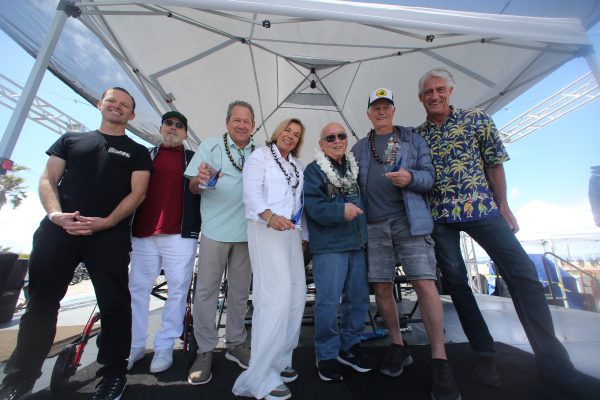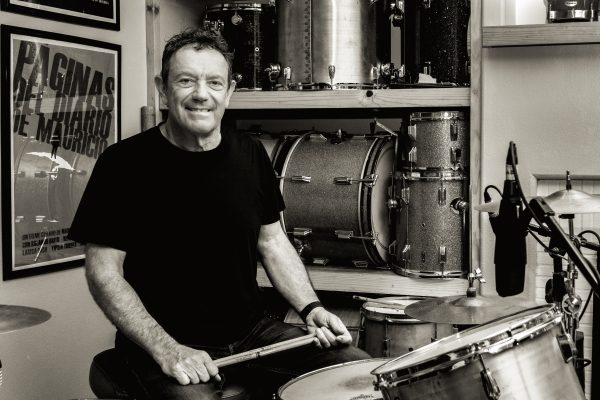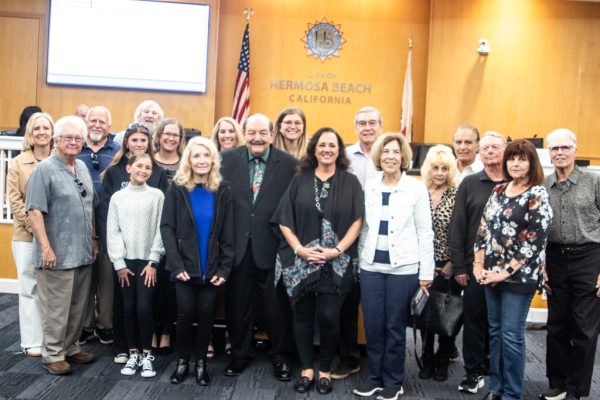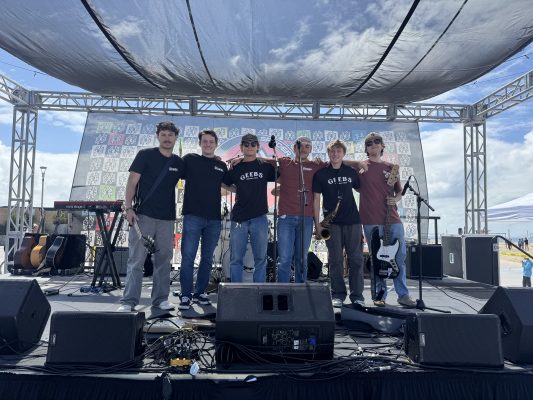
The AES power plant, with its expansive blue “Whaling Wall,” by famed muralist Wyland, and its towering smokestacks has dominated the Redondo Beach water front since 1897. Its stacks can be viewed from as far away as Malibu and Palos Verdes.
Now, a door has been opened that could re-shape the Redondo waterfront. AES is exploring downsizing its plant, while a grassroots community movement seeks to remove the plant entirely.
“Obviously this is a once in a generation opportunity to really upgrade our waterfront in one of several ways,” said Councilman Bill Brand at a council meeting a few months ago.

New regulations passed by the state of California limit “once-through” cooling, which utilizes ocean water to cool power plant turbines. As a result of the new regulations, AES is required to modernize its Redondo plant, and, in the process, plans to drastically shrink the footprint of the plant.
Local groups such as Building a Better Redondo, led and supported by councilmember Bill Brand, and the Facebook group “Tear Down Redondo’s Power Plant,” want to replace the plant entirely, with a public park. They have suggested the City Council change the AES’s zoning to prohibit a new power plant from being built on the site.
The City Council convened a special meeting Tuesday night to review the city’s options for the property.
AES owns the land and intends to submit its plans a new plant to the State by August.
“I can’t tell you today whether we’re going to build a plant or not,” said AES Southland President Eric Pendergraft. “But if it’s critical to our maintaining a reliable supply of electricity in the future, it’s important that we pursue this permit that would give us the ability to build a new plant if it is needed.”
Opponents argue that the Redondo Beach plant is not needed for grid reliability and that the local plant could become one of many across the state that have been decommissioned, opening the door for a park or other options.


“When we submit that application, that begins what is likely going to be a three- to five-year public review process,” said Pendergraft. “The benefit of that public process is that it will be based on our actual project with our accurate details and every detail you can imagine as opposed to speculation and assumptions as to what we’re planning to do.”
Members from five State regulatory agencies – including the California Energy Commission (CEC), California Independent System Operator (CAISO), the Southern California Air Quality Management District (SCQMD), California Public Utilities Commission (PUC) and Southern California Edison Company – were invited to the podium to talk about their involvement in the re-licensing of the AES power plant and answer questions regarding the process.
“This is a meeting all of us have been excited [about] for quite some time,” said Mayor Mike Gin. “We wanted to become educated on the processes because the approval or review of any potential new license for a new plant is a really Byzantine process.”
Community members packed the chambers, filling the aisles, and an overflow room in the public library. Members of No Power Plant and BBR were stationed outside the glass doors of the chambers with posters, buttons and literature.
“NO NEW POWER PLANT,” one sign said. “CAL ENERGY COMMISSION: PLEASE DON’T ALLOW A NEW PLANT,” said another.
Once the experts took to the stage, a rapt silence blanketed the room as people listened.
Roger Johnson from the CEC explained that the licensing process for a new power plant will include extensive reviews of the application and wide-ranging data analysis. Two commissioners will host public workshops and hearings and community concerns will be addressed thoroughly, he said.
“We ensure the project is in compliance with laws, ordinances, regulations, and standards,” said Johnson. “We identify issues and explore alternatives, identify mitigation measures in addition to certification. We facilitate public and agency participation throughout the proceeding. It’s not unusual to have a dozen workshops across a project.”
Dennis Peters from CAISO talked about the balancing act the State is trying to strike by having fewer gas generated plants and maintaining reliability of power throughout the grid.
“We have a lot of challenges ahead of us,” said Peters. “[Because of regulations] we’re looking at trying to maintain reliability with fewer gas fired plants.”
He explained that in the L.A Basin there are four natural gas-fired plants subject to regulations, including Redondo Beach, and if all four were to retire because of once-through cooling regulations, the LA Basin’s local capacity requirement of 10,589 MW would leave the area 3,207 MW short of necessary power.
Mohsen Nazemi from SCQMD discussed air quality issues. He said AES cannot begin any new construction without receiving a permit from their agency, and failure to receive a permit could result in no-go for re-powering.
Denise Tyrrell from the PUC emphasized the commission’s commitment to meeting the power needs of California while insuring safe, reliable, reasonably priced public utilities.
Patricia Arons from Edison addressed the costs and benefits of building a new power plant at a new site versus modernizing the current Redondo Beach plant. She said modernization in Redondo Beach would be far cheaper than building in a new area.
“These various policies and programs will result in cleaner, smarter and more secure generation system,” Arons said. “But the transition involves enormous capital investments that ultimately will be reflected in the rates that customer plays. Balancing public policy and regulatory requirements with our responsibility to safely provide reliable and affordable electricity is very challenging.”
After the experts were finished talking, almost an hour and fifteen minutes had gone by. Brand began his questions by asking Johnson if a project had ever been overturned by the State Supreme Court.
“The commission has been appealed several times,” answered Johnson. “But never overturned.”
He also asked Peters if there was the capacity of retiring one once-through power plant and still maintaining grid reliability.
“We look at that 3,277 MW needed to be replaced and we’re not specifying where that needs to be,” said Peters. “We would agree with Arons’ comments from Edison that the best, most cost-effective location would be at existing sites.”
“Just to reiterate,” said Brand. “There is capacity to retire some of the once-through cooling capacity.”
“Yes,” Peters answered.
A stony silence filled the room.
After an hour of Brand’s questions, the other council members questioned the speakers.
“Now a lot of back and fourth has gone on tonight,” councilmember Pat Aust said to Johnson. “AES hasn’t initiated the process, is that correct?”
Johnson answered to the negative and explained that the process for the application could take upwards of 18 months to approve, depending on public participation.
“If you just turn around for a second, would you call this a lot of participation for a city our size?” Aust asked.
“No,” Johnson answered.
“Look outside!” people shouted. “Look outside — there are more than 30 people out there!”
“One of my points is that people are saying we are way too late in this process,” said Aust. “They’re saying we should have gotten involved a lot earlier. And it really wouldn’t have helped much to get involved earlier because the process hasn’t begun. This is the first step.”
Brand felt differently. “We shouldn’t be waiting any longer for anything,” he said in an interview after the meeting. “We should get moving. If we slow roll this, the gears are going to start turning and it’s going to be much harder to stop the machine.”
Dozens of citizens waited through the entire five hours of questioning. After council members got their questions answered, it was the public’s turn. Sixteen people handed in their red cards and took the podium.
Dan Buck, a 25-year Redondo Beach resident, stood up with an oxygen tank on his back and voiced his concern about the health aspects of a continued plant in Redondo Beach.
Jennifer Didlo, project director of the AES Southaland Repower Team, spoke with excitement about the beginning of the permitting process.
“AES is really excited about the opportunity that’s in front of us,” Didlo said. “This is really our chance, collaboratively, to redefine the water front, redefine the skyline [and] reinvigorate the harbor area. We really think the AES plant is the right solution and we look forward to working with the city to make sure we have a project that embraces the character of the community, furthers the California clean air objectives, frees up some highly valuable waterfront property, continues to provide local jobs and much needed tax revenue to the city.”
Council members moved to continue the public hearing to next Tuesday’s council meeting. Community members continued to voice their opinions until the red cards ran out.
“We’re a very tight-knit, small, beach-front community,” said BBR leader Jim Light, the final speaker of the night. “We’ve had a power plant looming and blighting our water front for years and years… I have to believe there is a way to find that you do not need this plant for grid reliability.”











